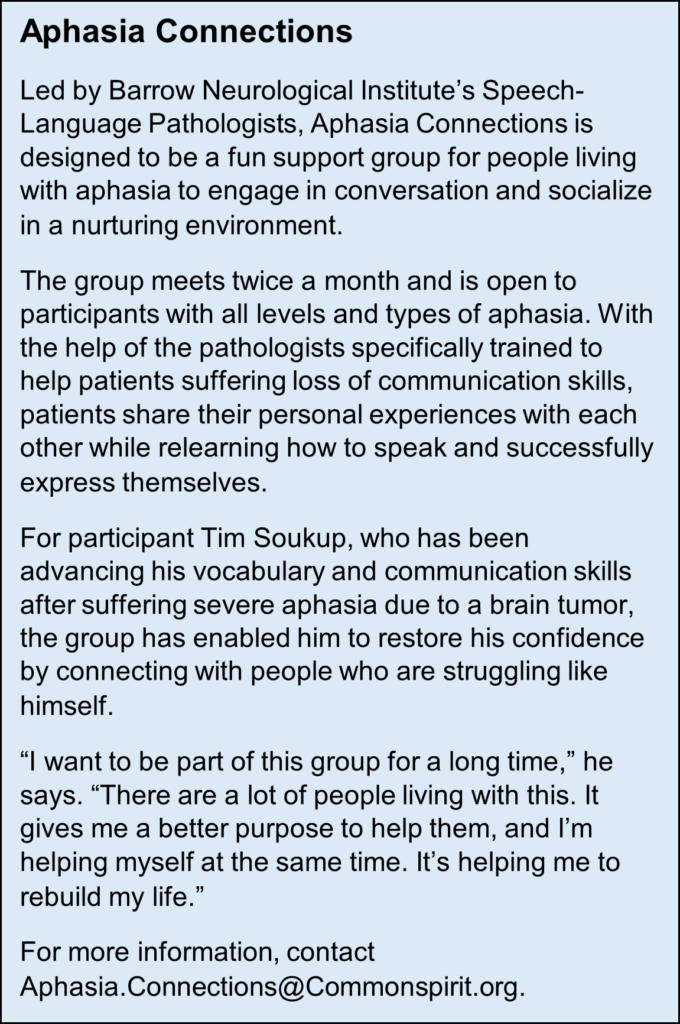
Ivy Blog
Running—and the Ivy Brain Tumor Center at Barrow Neurological Institute—Saved Dad’s Life After Brain Tumor
- February 14, 2025
- Ivy Center
- Posted in Patient Stories

Tim Soukup never expected running to be his lifeline. A father of four and a finance executive, Tim picked up running for fitness and stress relief after watching his own father undergo triple bypass surgery. His two eldest sons were standout runners, and joining them on the road was his way of staying fit, and staying close.
“I had a lot of stress and thought I’d die from it,” he says, half-joking. A decade later, running would do more than keep him healthy. It would keep him alive.
A Relentless Drive
When Pat’s Run launched in Arizona to honor Pat Tillman, the fallen war hero and former ASU quarterback, Tim—who’d attended ASU at the same time Tillman did—signed up with his boys. The 4.2-mile event became a tradition. Over time, he pushed himself—first to half-marathons, then the grueling 26.2-mile full distance.
“I’ve got a lot of drive, so I started to really train,” he explains, lamenting that he clocked his first marathon at five hours, getting sick on many miles. But he kept at it, determined to qualify for the Boston Marathon.
His sons, now state cross-country champions, warned him that qualifying would only get harder with age.
“But when they left for school, it became about me,” he says. “I wanted to show them I could do it.”

The Diagnosis That ‘Changed Everything’
December 2018. A normal morning. Tim’s wife was out of town, and he was getting his 10-year-old daughter ready for school. Then—
“I came out and couldn’t speak. Not a word. It was just gone,” he recalls.
His daughter, remarkably calm, suspected a stroke. She guided him to sit down. Five minutes later, his speech returned. He dropped her at school but knew something was wrong.
The next day, after sharing the experience with his wife, Tim went to the nearest emergency room where the doctors confirmed it: a tumor in the speech center of his brain. A physician delivered a grim prognosis — “You probably have a year to live.”
Tim was referred to Barrow Neurological Institute, where Dr. Nader Sanai—chief of neurosurgical oncology at Barrow, director of the Ivy Brain Tumor Center, and a world-renowned brain tumor expert—led his care.
Surgery, Aphasia and Fight to Recover
Three weeks later, Tim underwent an awake craniotomy. His tumor —an oligodendroglioma—was removed while he remained conscious.
The operation was a success, but it came at a cost. Tim woke up unable to speak. Severe aphasia had erased his ability to process language. He could no longer talk, read, write or work. His career was in jeopardy, and his world went silent.
“Aphasia is often a lifelong diagnosis that can lead to a loss of identity, employment, and connection with family, friends, and others in the community,” explains Stephanie Voss, a speech-language pathologist at the Outpatient Neuro-Rehabilitation at Barrow Neurological Institute, who has worked with Tim during his recovery.
Recovery was brutal. He couldn’t talk, read, write, drive, or even take care of himself. The math and finance skills that defined his career had disappeared. For two years, Tim withdrew. He attended recommended support groups—available through the Gray Matters Foundation and Barrow’s Aphasia Connections (see sidebar)—but he couldn’t understand what was being said, and eventually he gave up.
Despite losing his ability to speak and having to relearn how to walk, Tim still had running. One month after surgery—guided every step by his son—he completed the half-marathon he had trained for.
Rebuilding Life, One Word at a Time
Eventually, Tim returned to Barrow’s Aphasia Connections support group, where specialists helped him rebuild his vocabulary. He practiced. He struggled. He kept going.
“I needed to just start over,” he says. “I’d lost more than half my words, but I knew which ones I could use. I wanted to help others.”
“It became a safe place to practice talking and help others, but I think they help me just as much or more,” he adds. “It’s very rewarding.”
“When I first met Tim, he was struggling to understand his linguistic challenges and integrate back into daily life,” says Voss. “Today, despite the challenges that aphasia presents, I see Tim flourishing. At Aphasia Connections, he supports and encourages other group members through his success, openness, and positivity.”

While sharing his story, Tim has realized he’s in a much better place, recognizing he received a second chance at life thanks to the team at Ivy Center and Barrow, from his initial surgery to follow-up care and continued support through Aphasia Connections.
“They know exactly what they’re doing, and this experience has been amazing,” he says. “They have been like family to me. They’ve given me five more years to live!”
The Finish Line
Today, Tim has reclaimed much of what was lost. His tumor has not returned. He’s back behind the wheel, caring for his two youngest children. And he’s still chasing that Boston Marathon dream.
The Road to Boston
Last January, he completed the Mesa Marathon nearly 30 minutes faster than his pre-tumor record, officially qualifying for the Boston Marathon. Although his time was just 16 seconds short of gaining entry to the actual race, he’s racing again this February, determined to secure his spot.

His family even designed T-shirts honoring his journey, inspired by the only words he could say during his awake surgery:
“All I could say was 2-4,” he reminisces. “Mile 24 is the last two miles left in a marathon, when you’re dying, but you’ve got to push past to get to the finish line.”
“The warmth, humor, and courage Tim exemplifies are an inspiration to so many … and a reminder that there is hope after a brain tumor and aphasia,” says Voss.

